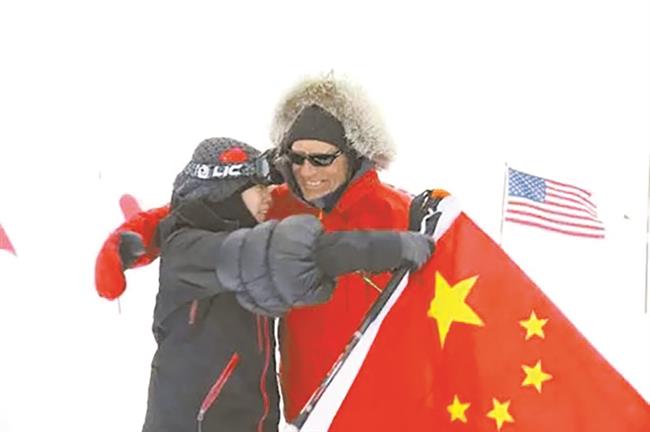A Chinese woman's extraordinary lengths to conquer Antarctic


Feng Jing gave up a well-paid job and went on to become the first Chinese woman to ski to the South Pole.
For the past three years, Feng Jing has ran half a marathon and lifted heavy weights for hours every day, or walked around her apartment for five hours at night carrying a tire for weight training.
She is not an athlete.
Feng is an ordinary person who has been entranced by going to the South Pole.
Feng, 36, reached the South Pole on January 8 this year after skiing 1,130 kilometers, becoming the first Chinese female skier to achieve the feat.
The preparation for her 52-day expedition started in 2015 when Feng could not ski and had no experience of extreme cold weather.
“I know I’m a million miles different from other adventurers, but I’m determined and I spared no pain for my dream.” Feng says.
In 2010, Feng quit her job and started traveling worldwide. Having journeyed to over 130 countries and regions in six years, she wanted to make Antarctica her last destination.
She wrote e-mails to 15 polar guides, asking for suggestions and hoping to hire one of them to lead her to the South Pole.
Though honest, her introduction showed she was unqualified: a 1.64-meter-tall woman, weighing 50 kilograms, who was bad at sports and could not ski, wanted to complete a 1,130-kilometer expedition to the South Pole. The guides were not impressed.
“Four guides didn’t even reply to me, and 10 didn’t rate me,” Feng says. “But 63-year-old Canadian guide Paul Landry said the successful expedition depended on how much effort I could make.”
As one of the best-known polar guides in the world, Landry’s words made her believe that the expedition might be possible.
Feng’s preparation started in June 2015, and apart from exercise every day to build up muscle, she also practiced cross-country skiing in northern China, Norway and New Zealand.
Landry was impressed by Feng’s endeavor, but still offered three suggestions: to practice for one more year, to shorten the route to 890 kilometers, or to hire an assistant guide to carry Feng’s packing.
Feng rejected all of them. “What’s more important than reaching the South Pole was to try my best and rely on myself to the most extent to achieve my goal,” Feng says.

Feng hugged her Canadian guide Paul Landry after arriving at the South Pole in January.
Meanwhile, the price of mounting an expedition increases every year.
The venture cost her over US$300,000.
Feng started her expedition with Landry from the Hercules Inlet at Antarctica’s Ronne ice shelf on November 16, 2017.
She had to get up at 6am and ski for 10 hours dragging a 70kg sledge. She took two dehydrated meals during the day, and hot porridge for dinner.
Hurricane-speed winds, temperatures as low as minus 20 degrees Celsius, crevasse fields and sharp-edged grooves and ridges were dangers Feng faced at every step.
There were times when Feng really wanted to lie down in the tent to ease her pain and have a rest. “I wrote ‘every step’ on my snowboards and stared at the words, forcing myself to put one foot ahead of another and reach my dream step-by-step,” she says.
“I marked her route on the map, which was usually several millimeters a day,” says Tang Limao, Feng’s emergency contact person. “I stared at the thin line, knowing she was risking her life, enduring loneliness and pain to make progress.”
The arduous journey ended on January 8, 2018.
“It was midnight local time, and I was overwhelmed by the still and silent air, feeling satisfied,” Feng says. “The flood of emotion comes rushing back every time I think of the moment.”
Feng called her mother: “Mom, I’m here.” They both cried.
“I have never had a client who works as hard as you do,” Landry told Feng after their venture.
The seasoned explorer has led groups to the Geographic South Pole, across the Antarctic continent and to the Pole of Inaccessibility.

Feng's endeavor left her numerous wounds and injuries.
During her expedition, Feng met Japanese adventurer Yasunaga Ogita, who completed the task by trekking solo, and 61-year-old British explorer Robert Swan, who reached the South Pole with his son.
Such people inspired Feng, who says that she hoped her experience would encourage more people, especially women, to set out and explore the world.
“Many women are pursuing a stable family life, and there is nothing wrong with that,” Feng says. “But life can be more interesting if they live with a spirit of adventure, be more independent and free.”
“We should thank Feng for her adventure showed the potential of life and inspired all of us,” says Yuan Ming, who used to be Feng’s teacher at Peking University and is now dean of Yenching Academy at the university.
Feng plans to cross Greenland next year, and also hopes to conquer the Southern Pole of Inaccessibility, the point on the Antarctic continent most distant from the Southern Ocean, in the near future.
“My favorite poem encourages me and keeps my passion for life,” Feng said.
That poem is, “I’d pick more daisies” by the American poet Nadine Stair, “If I had my life to live over, I’d dare to make more mistakes next time. I’d relax, I would limber up... I would climb more mountains and swim more rivers.”















